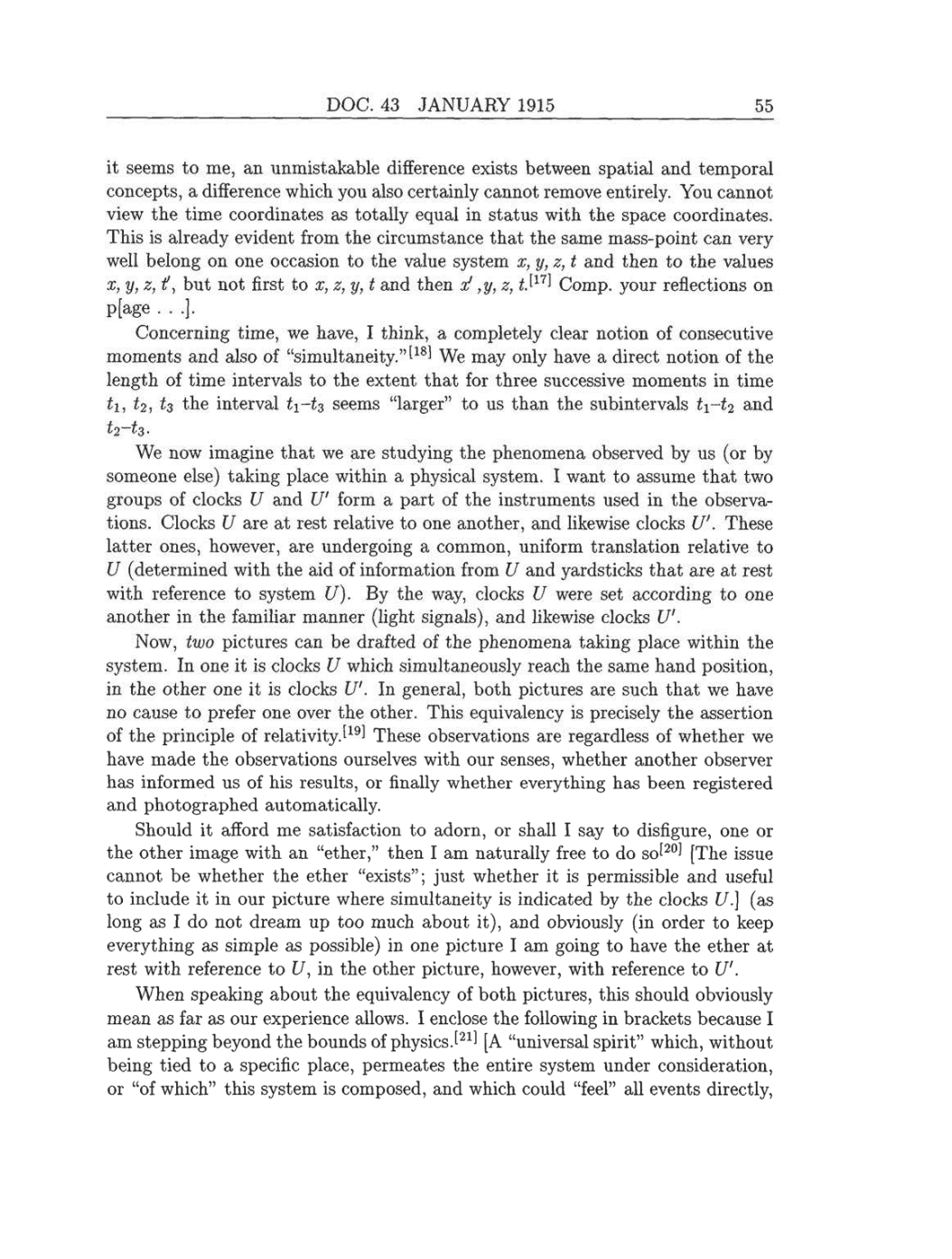DOC.
43
JANUARY
1915 55
it
seems
to
me,
an
unmistakable difference exists between
spatial
and
temporal
concepts,
a
difference which
you
also
certainly cannot
remove
entirely.
You cannot
view
the time
coordinates
as
totally
equal
in
status
with
the
space
coordinates.
This
is
already
evident from
the
circumstance
that
the
same
mass-point
can
very
well
belong
on one
occasion to
the
value
system
x, y, z,
t
and
then
to
the
values
x,
y, z,
t',
but
not first to
x, z, y,
t
and
then
x'
,y,
z, t,[17]
Comp, your
reflections
on
p[age
...].
Concerning
time,
we
have,
I
think,
a completely
clear notion of consecutive
moments and also of
“simultaneity.”[18]
We
may only
have
a
direct
notion
of
the
length
of time intervals
to
the
extent
that
for
three
successive
moments
in time
t1, t2, t3
the
interval
t1-t3
seems
“larger”
to
us
than
the subintervals
t1-t2
and
t2-t3.
We
now imagine
that
we are studying
the
phenomena
observed
by
us
(or by
someone
else)
taking place
within
a
physical system.
I want to
assume
that
two
groups
of clocks
U
and U' form
a
part of
the instruments
used in
the
observa-
tions. Clocks
U
are
at rest relative to
one
another,
and
likewise
clocks U'. These
latter
ones, however,
are undergoing a common,
uniform
translation
relative to
U
(determined
with the
aid of information from
U
and
yardsticks
that
are
at rest
with
reference
to
system
U).
By
the
way,
clocks U
were
set
according
to
one
another
in
the
familiar
manner
(light signals),
and
likewise clocks
U'.
Now,
two pictures
can
be
drafted
of
the
phenomena taking place
within
the
system.
In
one
it
is
clocks
U
which
simultaneously
reach
the
same
hand
position,
in
the other
one
it
is
clocks
U'.
In
general,
both
pictures
are
such
that
we
have
no cause
to
prefer
one over
the
other. This
equivalency
is
precisely
the
assertion
of
the
principle
of
relativity.[19]
These
observations
are
regardless
of whether
we
have made
the
observations ourselves with
our
senses,
whether
another
observer
has informed
us
of his
results,
or
finally
whether
everything
has been
registered
and
photographed
automatically.
Should it afford
me
satisfaction
to
adorn,
or
shall
I
say
to
disfigure,
one or
the other
image
with
an
“ether,”
then
I
am
naturally free to
do
so[20] [The
issue
cannot be whether
the ether
“exists”; just
whether it
is
permissible
and useful
to
include it in
our
picture
where
simultaneity
is
indicated
by
the
clocks
U.]
(as
long
as
I
do not dream
up
too much
about
it),
and
obviously
(in
order to
keep
everything
as
simple
as possible)
in
one
picture
I
am
going
to
have
the ether
at
rest with reference to
U,
in
the
other
picture, however,
with reference to U'.
When
speaking
about the
equivalency
of
both
pictures,
this
should
obviously
mean as
far
as our
experience
allows. I
enclose
the
following
in brackets because
I
am
stepping
beyond
the
bounds
of
physics.[21]
[A
“universal
spirit” which,
without
being
tied
to
a
specific place, permeates
the
entire
system
under
consideration,
or
“of
which”
this
system
is
composed,
and which could
“feel”
all
events
directly,
